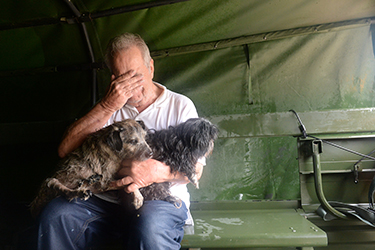This guest post is by Jyoti Mishra, PhD, MBA, co-director of the University of California Climate Resilience Initiative. An associate professor of psychiatry at the University of California-San Diego, Mishra spoke about climate trauma during an APHA webinar in spring.
When we think about climate change, it can arouse anxiety and worry, especially given the stories of doom and gloom that are perpetually at the forefront in the media.
And yet for many of us who are involved in climate action and advocacy, our changing climate also conjures emotions of hope and connection with others who we engage with collectively in addressing this crisis. Indeed, throughout history, we humans have been at our best when uniting to respond to challenges.
While climate change itself may have become politicized, the physical and mental health impacts of the changing climate and resulting weather extremes and frequent disasters, such as intense wildfires and floods, are undeniably affecting people in many U.S. communities, regardless of political affiliation.
Exposure to climate disasters can lead to long-term mental health effects known as climate trauma. Such impacts include symptoms of post-traumatic stress disorder, anxiety and depression — so widespread that up to a third of a community population can show clinical symptoms months or years after being exposed to a disaster.
Research shows that climate trauma impacts are inequitable and a climate justice issue, particularly because climate extremes and disasters impact vulnerable communities the most. These are communities that are already extremely poor, have low existing access to health care resources, and have contributed the least to anthropogenic climate change.
Public health can play an important role in combating climate trauma. From the lens of public health, political affiliations or opinions regarding climate change don't matter. What matters is that we provide prompt solutions for post-disaster recovery and develop community resources that build resilience in the long term. It's important that community members are educated and made aware of the grave climate trauma impacts. Community-wide solutions that benefit mental health and well-being should be implemented.
Among those are nature-based solutions. Some climate disaster-impacted communities are adopting nature-based mindfulness. These practices can resolve climate trauma by gradually transforming nature as threatening in the context of disaster, to nature as soothing, refreshing and rejuvenating.
Climate action projects where community members can come together and work toward local sustainability or eco-stewardship solutions also build resilience. This involvement and supportive group activities in turn benefit mental health and well-being. We are imparting these very community-building resilience skills as part of the University of California Climate Resilience Initiative to youth all across the state.
Let’s commit to the public health approach, and build community cohesion and resilience together. That is the antidote to climate trauma in this new world of a rapidly changing climate that we inhabit.
Photo caption: A survivor of a flood along Cypress Creek in Kerr County, Texas, rests in a shelter in 2017 after Hurricane Harvey swept through the region. The Texas National Guard rescued 2,400 people from flooding along the creek. (Photo by Capt. Martha Nigrelle, courtesy U.S. Army National Guard via Flickr Creative Commons)